1. April 2020 | Education and Chances of Employment
Effects of population changes on the labour market in Germany

Starting in 2006, Germany has experienced a strong and long-lasting labour market upswing with record levels in employment year by year. In 2018, employment amounted to 44.8 million (Figure 1), which is about 94 percent of the labour force potential. Over the past 14 years, this exploitation rate has increased by a remarkable 9 percentage points. Not surprisingly, labour shortage has become more and more virulent.
Labour shortage has strongly increased during the labour market upswing
While in the register data of the Federal Employment Agency (Bundesagentur für Arbeit), there were only 0.5 vacancies per ten unemployed in 2005, this number has risen to 3.5 in 2018. Moreover, recruitment has become more time-consuming and costly. The share of hirings with difficulties because of a lack of applicants more than doubled to 33 percent within a few years (Figure 1a and 1b). The tight labour market incentivises companies to reduce their separation propensity to an all-time low or even conduct anticipatory hires. Hence, the labour demand increased due to the labour shortage that is already existing and/or is expected to become even more threatening.
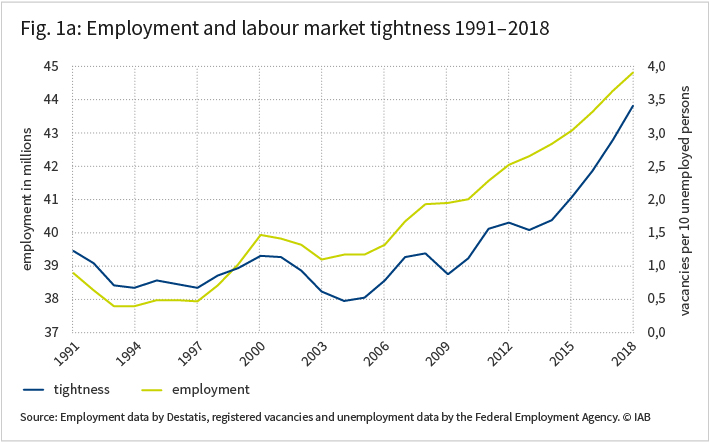
The steep employment growth attracted workers from outside the domestic labour force: Higher labour demand by the firms could be satisfied as migration and participation were large enough to ensure a sufficient increase in the labour force potential. However, net migration will not always be as high as in the recent past and there is hardly any potential to further increase participation rates. Thus, regardless of cyclical fluctuations, there will be supply-side effects that will slow down and even limit the steep upward trend in German employment in the near future.
Future development of the labour force potential
The total population in Germany amounted to 83.0 million by the end of the year 2018. The part of the population that is relevant to the labour market is called the labour force potential. These people are either employed, unemployed or belong to the hidden labour force. In 2018, the labour force potential amounted to 47.5 million, about 57 percent of the total population and 73 percent of the population aged 15 to 74.
Figure 2 shows scenarios for the future development of the labour force potential. These scenarios reveal the impact of the three driving forces: demography, migration, and participation.
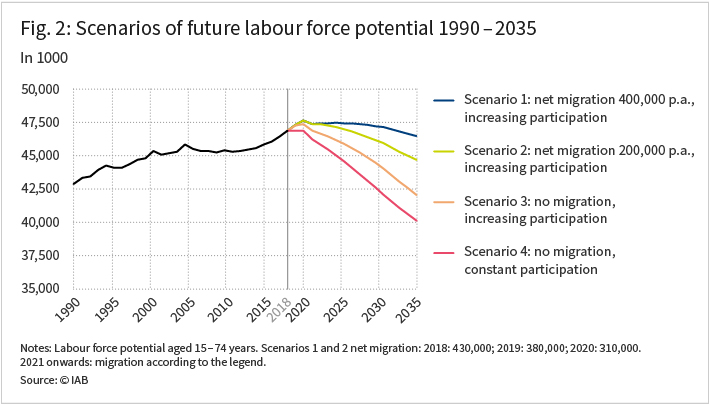
The ageing population drives the negative demographic component
As regards demography, fertility and mortality rates are often in the focus. However, with respect to the next 15 years, they hardly play any role in changing the major trends in the labour force potential. Mortality is almost irrelevant for the working-age population. Moreover, it takes decades until a change in fertility has significant effects on the labour force potential – even though the total fertility rate of women in Germany increased from 1.33 in 1991 to 1.57 in 2018. What is most important is the population already born and the size of the different age cohorts. Projecting this given data into the future leads to the demographic scenario, where only birth, death, and the ageing of the population are in effect (the red scenario in Figure 2). In the absence of migration and participation effects, the labour force potential would decline by 7.5 million people or 16 percent until 2035.
The main reason is the ageing population. Figure 3 shows the population by age projected for 2035 as compared to the situation given in 2017. The shift of the age distribution to the right reveals different trends. In case of the working-age population, aged 15 to 67 years, the lines in Figure 3 generally indicate strongly decreasing numbers caused by the ageing of the baby boom generation (in Germany, the baby boomers were born in the late 1950s and in the 1960s). In 2017, the baby boom generation was about 55 years old. The projections show that the cohorts forming this hump in the age distribution are going to leave the labour market during the 2020s. Consequently, while nowadays the smallest cohorts are in retirement age, it will be the largest in about 10 to 15 years.
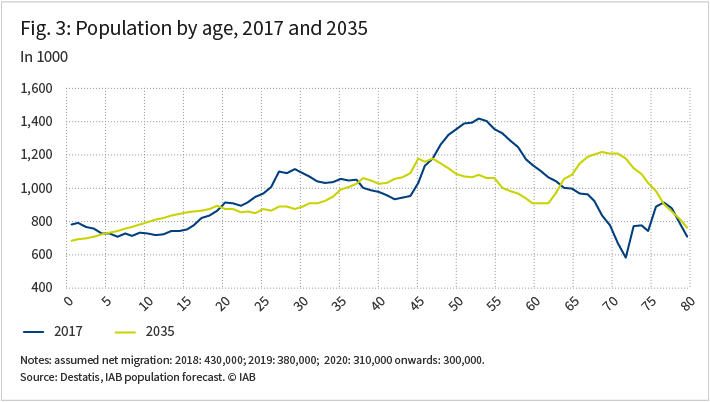
Participation rates of Germans can hardly be increased
The orange scenario in Figure 2 shows the effect of higher participation on the labour market. The more women enter the labour market and the longer older workers stay in their jobs, the higher is the labour force potential. However, this number of potential workers would still strongly decline by 5.6 million people or 12 percent – because there is limited potential for further increases in participation rates.
While participation rates of men are relatively high (99 percent at prime age) and stable, participation rates of women have changed over time and may increase further. However, participation rates of German women are quite high anyway. More than 90 percent of 40- to 49-year-old German women participate in the labour market. This limits the potential for a further increase. Any change depends on social norms as well as institutional settings regarding child care, other family work, part-time, and – for the elderly – the pension system.
Participation rates of female foreign nationals on the other hand, are up to 20 percentage points lower than those of their German counterparts. Certainly, many female migrants are not sufficiently integrated into society and culture as to adjust towards the German participation rates. If this could be managed successfully (targeting language skills, family responsibilities and traditional cultural differences), this would increase the labour force potential by several hundred thousand workers, as Johann Fuchs and his colleagues calculated in a study published in 2017.
Migration will postpone but not stop the decline in the labour force potential
The blue and green scenarios in Figure 2 add the migration effect. As migration is volatile and hard to forecast, a set of assumptions regarding the size of the net migration is reasonable. Looking into the past, strong spikes in immigration often depended on changes in the institutional setting (e.g. EU enlargement), and the social and economic well-being here and in the home countries. For example, high inflow rates by German resettlers from Eastern and Southern Europe drove up the migration balance after the German reunification. A steep rise of non-German nationals since 2011 has been caused by the EU financial crisis, immediately followed by a high level of refugee migration. Between 1991 and 2018, the average migration balance was 300,000 per year. It was less than 200,000 persons per year between 1991 and 2014 before the large inflow of refugees started. Thus, an assumption of 200,000 net migrants per year to be used in labour supply forecasts seems to be quite reasonable, while an annual net inflow of 400,000 would declare extraordinary numbers to be the new standard.
In either case, the decline in the labour force potential could be postponed and moderated. But it cannot be stopped: in the more realistic case, assuming 200,000 net migration, the labour force potential would shrink by 2.7 million people or 6 percent from 2017 to 2035; in the optimistic scenario (400,000 net migration), by half a million people or 1 percent.
Beyond the pure number of net migrants, migration has an impact on the labour supply via the age distribution as well as via participation. Population ageing could be moderated because migrants are typically younger than the average population. Indeed, the cohort of people who were around 30 years old in 2017 and will be just before 50 in 2035 will grow. Still, net migration is too small to change the age distribution given by the resident population considerably. On average for the years 1991 to 2018, net migration increased the total population by 0.4 percent per year only. Nevertheless, as immigrants are comparatively young, they will stay in the labour force potential for a longer time. However, one should take into account that the more migrants Germany attracts to the labour market, the more migrants will have claims against the pension system once they have retired themselves.
The demography calls for adjusting the labour demand and the social security system …
Summarizing the scenarios regarding the evolution of the German labour force potential, the picture is clear: As soon as the baby boom generation starts to retire, we must expect a decrease in the labour supply. The consequences will be manifold. The labour demand will have to adjust to mitigate further labour shortage. But first and foremost, the social security system will end up in a precarious situation. Obviously, a pay-as-you-go pension system as the one in Germany will come under very strong pressure in a shrinking economy. Depending on the specific scenario given in Figure 2, the old-age dependency ratio will increase more or less strongly. In 2017, there were 42 people aged 65 or older per 100 workers aged 20 to 64. In 2035, even in the most favourable blue scenario, it will be 58 elderly people per 100 workers. In such an environment, one can no longer rely on the so-called intergenerational contract according to which the pensions of the previous working population are compiled by the current one. Moreover, an older population will be a stronger burden on the health insurance system.
… which must be tackled from different directions
The problem for social security, mainly pension and health care systems, must be tackled from either side: revenues as well as expenditures. Revenues could be raised by either higher productivity which yields higher income, or by a lower decline in the labour force not only with respect to numbers but also with respect to hours worked.
Digitization may help to mitigate the decline in the labour supply via higher productivity. This would also reverse a recent trend of low productivity growth in Germany. As a first hint, a study by Francesco Carbonero and his colleagues in 2018 did not find any harmful effect of automation for labour markets in developed countries. In contrast, automation substitutes workers in developing countries where there is no ageing problem.
Meeting the desired working time would help a bit
As Johann Fuchs and his colleagues pointed out in 2013, working time prolongations would have to be unrealistically high to compensate for the demography-driven loss in workers. However, partial improvements can be achieved provided that the desired working time of both employed and unemployed will be realised. According to the Socio-Economic Panel data from 2017, the share of involuntary part-timers in total part-time employment is one fourth. Even more precisely, Figure 4 gives underemployment rates on an hourly basis, separately for age groups and gender. This analysis is based on the consideration that unemployed workers could find jobs with their preferred working time and workers who wish to work more could extend their working time, indeed (a negative component of workers who wish to work shorter hours is also taken into account). For example, the respective underemployment rate for 15- to 19-year-old women is about 9 percent. This means that the total hours worked by this group could be 9 percent higher if they all found the appropriate job and working time arrangement.
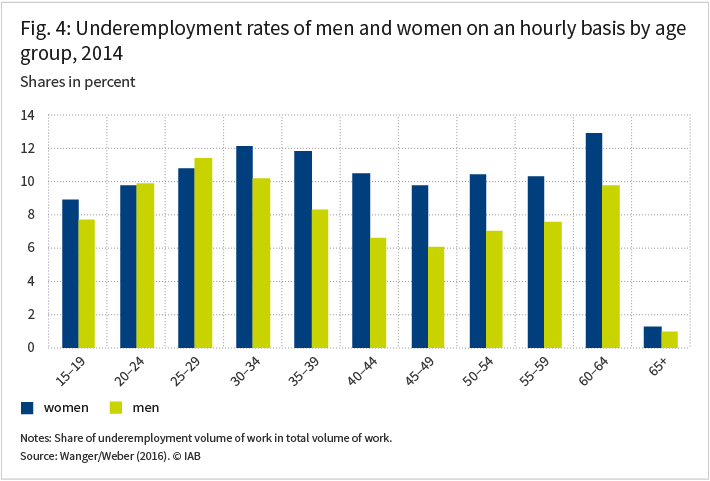
The figure impressively shows that there is an overall potential, though limited, to mitigate the decline in the labour force by longer hours of at best 13 percent. For male prime agers, however, an improvement by only 6 percent would be possible. In most age groups, there are more reserves with women than with men. Especially after the family starting phase, women would like to work longer than they currently do.
Germany competes for skilled immigrants
As Germany competes with many other countries for well-skilled immigrants, a new law on skilled labour immigration has been launched. Most important is the newly established equality of skilled workers with vocational qualifications and skilled workers with academic qualifications. Moreover, the proof of precedence will be largely abolished. A few exceptions aside, the basic principle regarding the recognition of the equivalence of professional qualifications acquired abroad shall remain in place. Hence, the main obstacle to the immigration of skilled workers will persist. However, the options for job search, apprenticeship search, and residence for recognition of professional qualifications have been extended or newly created but are quite restrictive still.
The pension system is under review
In order to limit the expenditures in the pension system, the regulations regarding the entry into retirement are frequently under discussion. While in the 1960s, retirees had claims against the pension system for an average of about 13 years, this period has increased to almost 18 years (men) and 21 years (women), respectively. The pensionable age did not rise adequately with life expectancy. This is why a link of pensions to life expectancy is often demanded, also because this is a reliable statistical measure and easier to practice than the current pension sustainability factor.
Higher retirement age: The German Pension Insurance reports an actual retirement age of 62 years in 2017. However, starting in 2012, the legal retirement age has been rising stepwise. By the year 2031, it will have reached 67 years. The effect of this change in the retirement regime on the labour force potential has already been considered in the scenarios of Figure 2. As this might still not be sufficient, a further increase of the legal retirement age up to 70 years is discussed.
Naturally, the effect is large when the considered cohorts are large. In other words, an increase in the retirement age would be especially effective if the baby boomers had not yet retired. However, following the political debate in Germany, any further adjustment of the retirement age might be possible in the distant future only. Insofar, by way of example, an additional increase in the labour force potential by 1.5 million people would only be possible perhaps by the year 2060.
Flexible entry into retirement: Based on the IAB Job Vacancy Survey, Judith Czepek and her colleagues stated in 2017 that around one third of the companies with workers who were or have become entitled to a pension within the last twelve months tried to keep the pensioners. These were especially small companies because, for them, the retirement of even a few employees can imply a great loss of professional competence. When asked regarding successful measures, 60 percent of businesses reported shorter working hours, followed by 49 percent that offered very flexible working time. As of 2017, the Flexible Retirement Act (Flexirentengesetz) provides measures to extend working life and make the transition into retirement more flexible, which the companies regard as predominantly positive. The agreement with the abolition of the unemployment insurance contributions and the more generous additional income opportunities in the context of a partial pension is particularly high.
Conclusion
In order to reduce the negative consequences of demographic aging on the labour market and the social security systems, above all, the following parameters need to be adjusted: The regulatory and effective framework for the employment of women and the elderly must be improved further, Germany needs to increase its attractiveness for skilled migrants and its efforts to facilitate the integration of migrants into the labour market and society.
Literature
Carbonero, Francesco; Ernst, Ekkehard; Weber, Enzo (2018): Robots worldwide: The impact of automation on employment and trade. ILO Research Department working paper, No. 36, Geneva.
Czepek, Judith; Gürtzgen, Nicole; Moczall, Andreas; Weber, Enzo (2017): Halten rentenberechtigter Mitarbeiter in den Betrieben: Vor allem kürzere und flexiblere Arbeitszeiten kommen zum Einsatz. IAB-Kurzbericht, No. 16, Nuremberg.
Fuchs, Johann; Söhnlein, Doris; Weber, Brigitte (2017): Projektion des Erwerbspersonenpotenzials bis 2060: Arbeitskräfteangebot sinkt auch bei hoher Zuwanderung. IAB-Kurzbericht, No. 6, Nuremberg.
Fuchs, Johann; Wanger, Susanne; Weber, Brigitte (2013): Is it possible to compensate for the decreasing labour supply by increasing working hours? In: Marek Radvansky; Ivan Lichner (eds.), Impacts of ageing on public finances and labour markets in EU regions, Bratislava: SEVT, pp. 129-140.
Klinger, Sabine; Fuchs, Johann; Räisänen, Heikki (Hrsg.); Maunu, Tallamaria (Hrsg.) (2019): Country report: Germany. In: Effects of population changes in the labour market: an analysis of six European countries, Helsinki, pp. 54-66.
Wanger, Susanne; Weber, Enzo (2016): Erwerbspotenziale von Arbeitslosen und Erwerbstätigen: Das Stundenvolumen bringt zusätzliche Information. IAB-Kurzbericht, No. 8, Nuremberg.
Klinger, Sabine ; Fuchs , Johann (2020): Effects of population changes on the labour market in Germany, In: IAB-Forum 1st of April 2020, https://www.iab-forum.de/en/effects-of-population-changes-on-the-labour-market-in-germany/, Retrieved: 26th of April 2024
Authors:
- Sabine Klinger
- Johann Fuchs

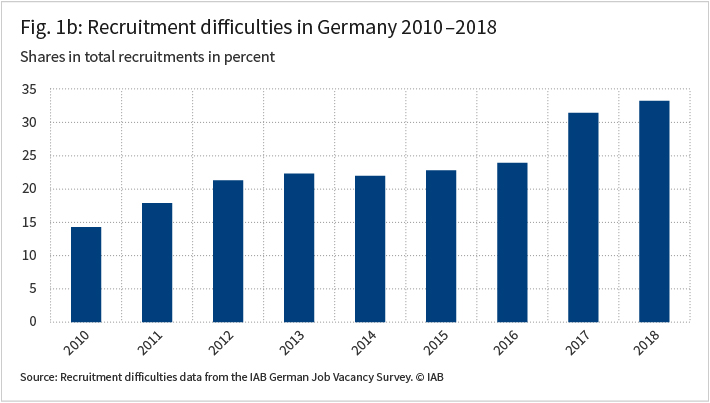
 Dr Sabine Klinger is senior researcher in the research department "Forecasts and Structural Analyses" at the IAB.
Dr Sabine Klinger is senior researcher in the research department "Forecasts and Structural Analyses" at the IAB. Dr Johann Fuchs is senior researcher in the research department "Forecasts and Macroeconomic Analyses" at the IAB.
Dr Johann Fuchs is senior researcher in the research department "Forecasts and Macroeconomic Analyses" at the IAB.